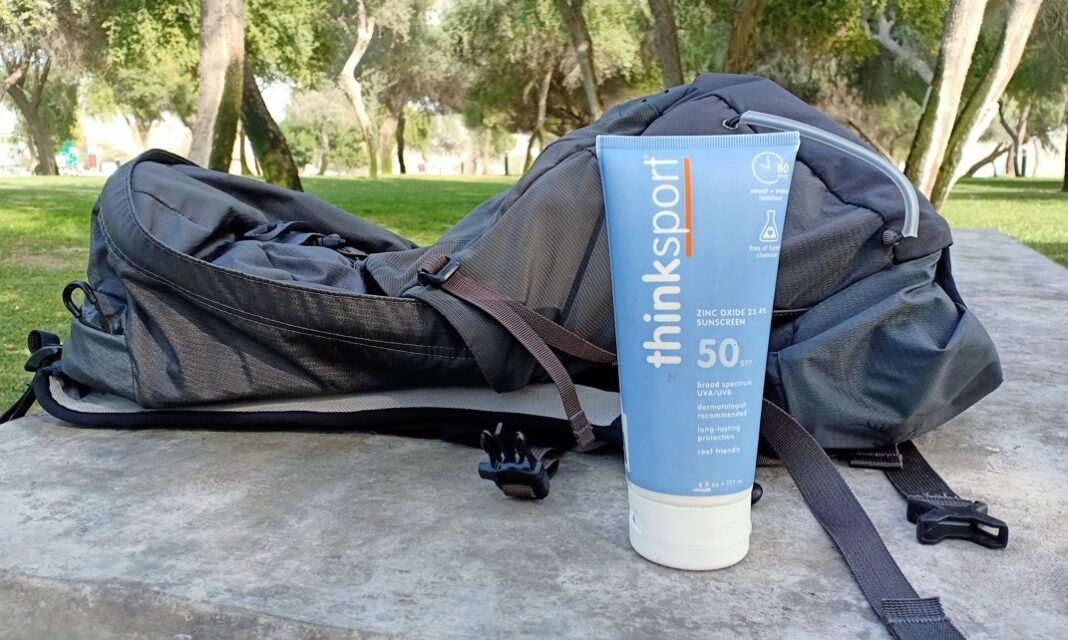The human body is a gift, and the skin is one of the most important parts. Keeping it fresh and lively needs a considerate effort. Like many other activities, hiking needs a lot of hydration to keep the skin safe and healthy. While water is important to keep the skin fresh and to save it from dust, burns, and UV, a hiker’s sunscreen is also crucial. It helps the user to stay fresh and healthy in the course of adverse weather conditions. This article will explore the types, uses, and details related to the best sunscreens for hiking, which is an important part of the backpack of a hiker.
Why Sunscreen is Essential for Hiking
Sunscreens are multipurpose protection layers for the skin. Firstly, it saves from UV radiation on the trail. UV rays break the fibers called elastin on the skin and cause the skin to sag, stretch, and lose its ability to recover.
Secondly, with every 1000 m (about 3,280 feet) increase in altitude, UV levels can increase by about 10-12%.
Sunscreens help keep the skin safer even in changing altitudes. Thirdly, naked skin during hiking is always in danger of sunburns. Overexposure to UVB causes skin inflammations. To avoid all the above risks, a sunscreen is essential for the hikers.
Best Sunscreens for Hiking Reviews
Thinksport SPF 50 Sunscreen
Thinksport SPF 50 mineral sunscreen is a reliable option for hikers owing to its all-round formula. Its broad-spectrum formula offers defense against UVA and UVB, which is a major concern for hikers, making it a perfect choice for sensitive skin, keeping you safe and hydrated while you hike.
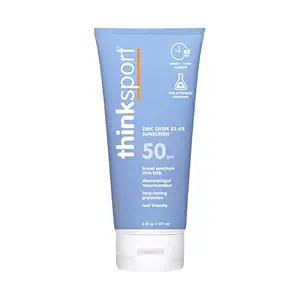
Additionally, Thinksport is a mineral sunscreen, which makes it environmentally friendly due to its ingredients like zinc oxide. Because of its mineral formula, this sunscreen is considered skin-friendly as well, allowing the skin to get in contact with more natural ingredients and avoiding any chemical substance.
Another standout feature of this sunscreen is its capacity for water resistance, which makes it long-lasting and helpful for sensitive skin cases. It lasts for almost 80 minutes in all weather conditions. Furthermore, its formula offers a non-greasy and non-sticky cream that readily absorbs into the skin and provides comfort throughout the day.
The lotion has no scent, which sometimes becomes a negative point for the hikers who prefer stronger fragrances; however, its protection level compensates for this deficiency as well.
The major ingredients of this cream include zinc oxide (34%), caprylic acid, glycerin, magnesium sulfate, different seed and fruit oils, triethoxycaprylylsilane, and natural fragrance oils.
Read More: Thinksport SPF 50 Sunscreen Review
Neutrogena Sport Face Sunscreen
Neutrogena Sport Face Sunscreen SPF 70 provides higher-order protection from the harms of sunlight to the hikers. Its Helioplex technology offers broad-spectrum protection from UVA and UVB. The formula of Neutrogena Sport Face is water-resistant and offers long-lasting protection.

Like Thinksport SPF 50, it also offers 80 minutes of long-lasting water resistance. It does not peel off in water, sweat, or even after rubbing mildly. For hikers with acne-prone skin or with sensitive skin types, this lotion provides an oil-free solution for maintenance of the breathability of the skin by keeping the pores open. It will not clog and block the pores of the skin.
Furthermore, the electrolyte complex in its formula offers a recovery of the skin and helps restore the skin’s natural balance. As discussed above, the SPF 70 in this sunscreen offers effective prevention from harmful sun radiations. Additionally, its mild scent keeps the hiker’s mood refreshing and light throughout the time.
Dermatologists recommend Neutrogena Sport Face as a reliable option for sun protection and skin-friendly lotion. Lastly, its ingredients include Avobenzone (3%), Octisalate (5%), Octocrylene (4%), Oxybenzone (5%), and Homosalate (15%), including some inactive components like acrylate, beeswax, benzyl alcohol, glycerin, and silica, among many others.
Banana Boat Light As Air SPF 50+
Banana Boat Light as Air SPF 50+ offers a unique option for the hikers who choose lightweight and non-greasy solutions as their sunscreen. The broad-spectrum protection of this lotion protects from UVA and UVB like the ones discussed above.
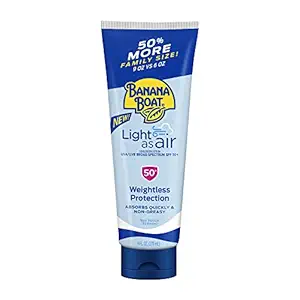
The SPF 50 refers to its ability to protect the skin from harmful sun rays and reduce the risk of sunburns on long hikes. Additionally, the lightweight formula offers protection for almost 80 minutes. Banana Boat is also water resistant, which enables the hiker to stay fresh and unharmed while sweating and in mild rains.
It keeps the skin pores open and clear, allowing the skin to stay fresh and hydrated without leaving a greasy residue. The formula of this lotion lacks oxybenzone and octinoxate, which makes it a safer option for sensitive skin.
Like some of the sunscreens, it offers less fragrance, which is favored by some hikers, while most of the adventurers prefer a higher and continuous fragrance while hiking. Lastly, the ingredients of this cream consist of avobenzone (3%), homosalate (9%), and octisalate (4%), among other inactive ingredients like silica, glycerine, tapioca starch, phenoxyethanol, coco-glucoside, and many others.
Moreover, the addition of aloe and panthenol provides a moisturizing and soothing effect, making it an apt option for hikers during sunny weather.
Comparison Table: Best Sunscreens
| Feature | Thinksport SPF 50 Sunscreen | Neutrogena Sport Face Sunscreen SPF 70 | Banana Boat Light As Air SPF 50+ |
|---|---|---|---|
| SPF Protection | SPF 50 | SPF 70 | SPF 50+ |
| Water Resistance | Up to 80 minutes | Up to 80 minutes | Up to 80 minutes |
| Sweat Resistance | Yes | Yes | Yes |
| Application Type | Lotion | Lotion | Lotion |
| Size/Volume | 3 oz (88 mL) | 3 oz (88 mL) | 3 oz (88 mL) |
| Broad-Spectrum Protection | Yes (UVA/UVB) | Yes (UVA/UVB) | Yes (UVA/UVB) |
| Skin Type Suitability | Sensitive skin-friendly (non-toxic, no parabens) | Designed for sensitive skin (oil-free) | Dermatologist-tested, suitable for sensitive skin |
| Formulation | Mineral (Zinc Oxide) | Chemical (Avobenzone, Homosalate, Octinoxate) | Chemical (Avobenzone, Octinoxate) |
| Reef-Safe | Yes | No | No |
| Non-Greasy/Finish | Matte finish, dries quickly | Light, non-greasy | Light, breathable finish |
| Packaging | Eco-friendly (BPA-free tube) | Regular plastic tube | Plastic bottle (recyclable) |
| Best For | Hiking, water sports, sensitive skin | Active outdoor activities, water sports | Light outdoor adventures, active sports |
How to Choose Sunscreen for Hiking
Since we have established that our skin is in danger of potential issues and sunscreen is a solution for it, let’s explore the ways that tell us about a good sunscreen.
SPF Level
Sun Protection Factor (SPF) is the indicator of how well a product protects our skin from damage from ultraviolet rays.
The SPF number indicates the capacity: the higher the number, the higher the protection capacity. For example, SPF 30, 50, and 100 protect from 97%, 98%, and 99% UVB rays, respectively.
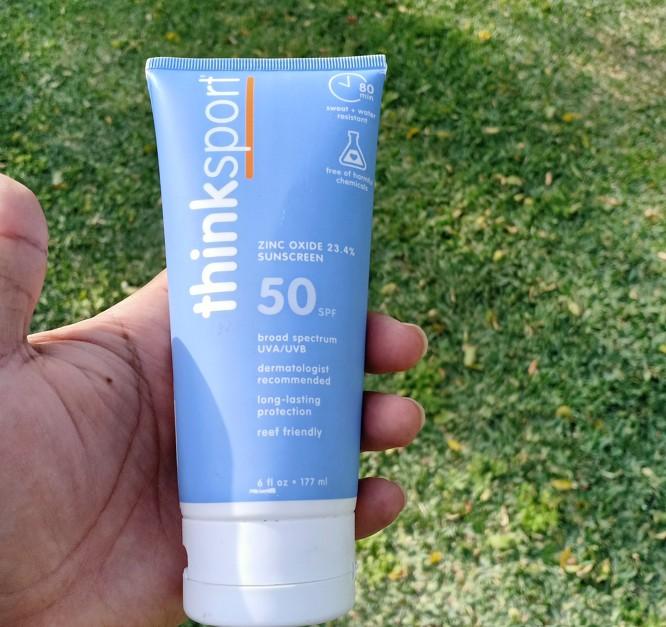
Dermatologists tested, approved, and proposed this aspect. No amount of SPF protects from 100% UV. However, for hikes, the experts advise SPF 30-50 for safety from most of the UVB.
Some factors require more protection than others; hence, we advise them to use more SPF than others. These factors include fairness of the skin, extended exposure to the sunlight, location, altitude, and health conditions.
For people with a history of skin cancer, genetic diseases such as albinism or xeroderma pigmentosum, or certain immune disorders, SPF 50 may not be enough. The experts advise a higher SPF for these conditions while going on a hike.
Water & Sweat Resistance
Hikers face changing environments. From terrains to rugged mountains and from rivers to gullies, they travel alike to reach the destination. For hikers, sweat and water are two factors that wash off their sunscreens.
After mild rain, a swim, or sweating due to an intensive hike, the sunscreen might come off if it is not waterproof. This may cause irritation in the skin and most likely in the eyes.
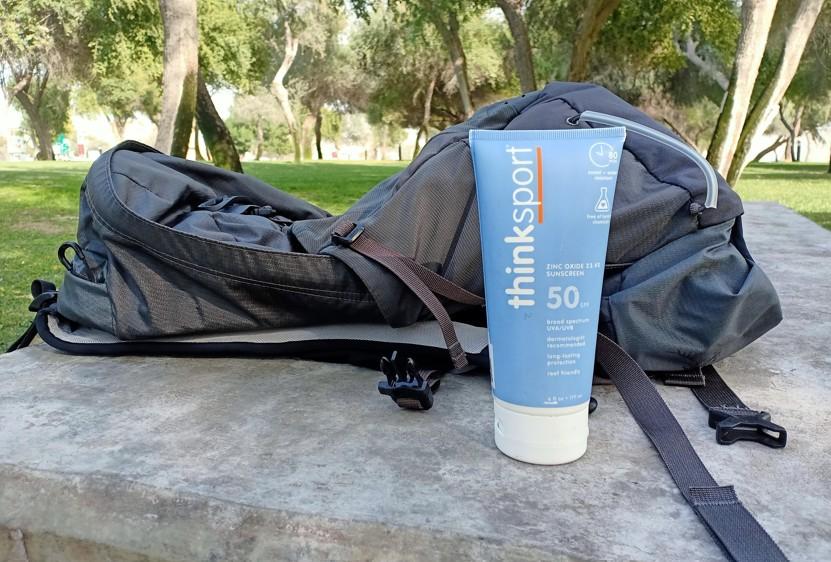
A normal sunscreen will peel off and expose the skin to the sunlight and dust, while a water-resistant sunscreen will stay put for at least two hours. Additionally, it will keep the pores in the skin open and will allow the sweat to smoothly flow and increase breathability.
Water-resistant sunscreens are lightweight and adaptable. These are highly recommendable for hikers, as their line of action includes confrontation with water and sweat on a regular basis. The hiker has to reapply the sunscreen only after two hours.
Broad-Spectrum Protection
Broad-spectrum protection refers to the capacity of a sunscreen to protect from UVA and UVB rays. These rays contribute to premature aging, wrinkles, and sunburn and are a significant factor in skin cancer.
Hikers face extensive days out in the sunlight, which means they are the most vulnerable people to face the negative impacts of UV rays.
The American Academy of Dermatology and Skin Cancer Foundation recommends using a broad-spectrum sunscreen with at least SPF 30 if you are a hiker. These recommendations are mostly an apt representation for the hikers and their line of work.
Some common ingredients in broad-spectrum sunscreens include zinc oxide, octinoxate, octisalate, and titanium dioxide, which are considered
Ingredients
Sunscreens mainly consist of two major types: mineral and chemical sunscreens. The former has zinc oxide and titanium dioxide, which create a physical barrier for the UV light and reflect it back.
The latter has oxybenzone, avobenzone, octinoxate, octisalate, and octocrylene and absorbs UV light, causing heat in the skin.
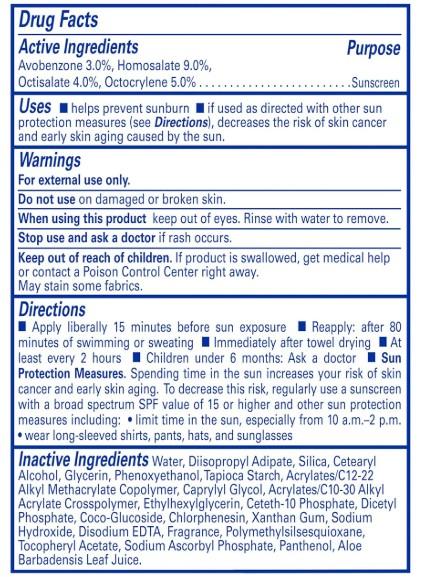
Mineral sunscreen leaves a white cast and is environmentally friendly, while chemical sunscreen absorbs into the skin and is considered harmful for coral reefs.
Typically, hikers use it on the basis of their skin type; however, mineral sunscreen is considered better for almost all types of skin and preferable to hikers.
Non-Greasy and Lightweight Formulas
Non-greasy and lightweight formulas offer sun protection using ingredients that cause less stickiness and heaviness.
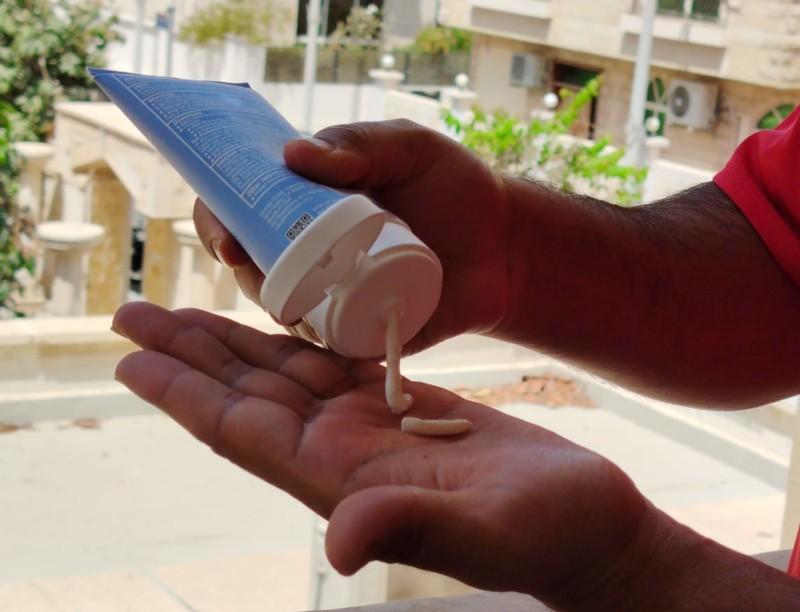
These formulas contain non-comedogenic elements, which do not clog the skin and hence keep the pores open and increase the breathability of the skin. These formulas offer comfort, absorb quickly, and are suitable for all skin types.
Skin Sensitivity Considerations
For hikers, it is crucial to choose a sunscreen that causes the least irritation. While choosing a sunscreen, the only factor that needs consideration is the skin type.
For sensitive skin, experts advise mineral sunscreens, which include zinc oxide and titanium dioxide. Chemical sunscreens cause irritation in the skin and disturb the skin rather than protecting it.
How to Apply Sunscreen During a Hike
Sunscreens must be used at least 15-20 minutes before exposure to the sunlight. Make sure that all the exposed skin is evenly covered with the lotion.
Most people apply too small an amount and rub it a lot, which is a wrong practice.
Apply amply, do not rub, and let it absorb. It is important to apply sunscreen to the thinning scalp of your hair, as it exposes skin.

In a thin scalp, UVB rays will weaken the hair roots and may cause baldness. Sunscreens often last 80 minutes; make sure to reapply after every two hours.
Also, apply after swimming and excessive sweating. Users often miss the ears and neck, which is not a wise choice. Also, keep SPF lip balm to apply on lips.
Too little sunscreen does not work effectively. Make sure to apply an ample amount wherever you are using it.
Additional Sun Protection Tips for Hikers
If you are a hiker, using sunscreen alone might not help. In order to stay safe and active, wear a hat and sunglasses as shades in addition to the primary protection.
Furthermore, long-sleeved shirts are advisable as a support to the sunscreen to prevent UVB. If you are a makeup enthusiast, wear makeup after the application of the sunscreen. Hikers face many rough outdoor situations, which include heat, sunlight, and rain.
Make sure to seek shelter if available. Dermatologists suggest users apply frequently, and in case of irritation in the skin, they advise seeking professional help.
Conclusion
Hikers must understand the fact that embarking on a trail doesn’t only mean walking from point A to B; it involves careful selection of gear and protection material. Sunscreens are important in this way. From choosing a sunscreen to using it rightly, there is quite a science behind the process. A sunscreen with SPF 50 and above can be useful for frequent hikers. Prevention of the skin from burns and UVA and UVB is crucial to sustain long hikes. Also, experts advise that the amount of cream must be ample to cover all the exposed skin of the body, while SPF lip balms can be an excellent option for the lips.
FAQs
What is the Best Sunscreen for Hiking?
Hikers are exposed to all weather conditions. For better protection, find a sunscreen that has SPF 50+, is water resistant, is prepared with mineral components, and doesn’t leave a glossy and greasy residue when applied. For example, Neutrogena Sport Face can be a great option for hikes, among others.
Should I wear Sunscreen When Hiking?
Yes, sunscreens are highly advisable to wear during hikes. It keeps the skin safe from dust, UVA and UVB sunlight, chemicals, and acidity in the rain. Also, sunscreens keep the skin fresh and moisturized to prevent damage in the changing weather patterns.
Is SPF 30 Enough for Hiking?
Dermatologists prefer higher SPF numbers for the outdoor hikes. The higher the SPF, the higher the percentage of efficiency, which means better protection from the UV rays. Hence, the conclusion is that the SPF 30 alone is not enough. Sometimes, weather conditions become severe, and a less efficient sunscreen might not work properly.
Is SPF 30 or SPF 50 Better?
There are a lot of factors at play while comparing sunscreens with SPF 30 and SPF 50. The percentage efficiency increases with SPF number; it indicates that SPF 50 is better. High-number SPFs do not necessarily last longer than lower-number SPFs, which means SPF 30 cannot be considered the least effective. There are also other factors besides SPF alone that contribute to how well a sunscreen works, including the quality of ingredients. So, we cannot outright declare one sunscreen better than the other based on SPF alone.

